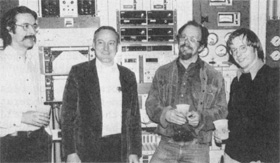"Pioneer" Experiments Wind Down
The Internal Target Group recently reached a milestone in its experimental program. Three groups have completed experiments there during the past months, in each case bringing to a successful conclusion a series of experiments running more or less continuously since the early days of Fermilab high energy physics.
In November 1977 the Soviet-American collaboration completed Experiment 289, a study of small angle p-He scattering. This collaboration, working at CZero since 1972, first developed a cryogenic H2 jet for use in internal target experiments. Its members include Edgar Jenkins, Ernie Malamud, Mitsuhiro Miyajima, Ryuji Yamada, Anatole Kuznetsov, Vladimir Nikitin, Yuri Pilipenko, Andrezej Sandacz, Boris Morozov, Peter Nomokonov, Vitali Smirnov, Adam Bujak, and Dan Gross. This jet, designed by Yuri Pilipenko and Victor Bartenev, produces high jet density while maintaining good Main Ring vacuum.
Experiment 522 by the Indiana University group, studied inclusive polarization in p-p scattering. Its members include Steve Gray, Bryan Martin, Homer Neal, Harry Ogren, Robert Polvado and Dave Rust. They first began working at CZero in 1974 on Experiment 313.
Experiment 552 by the Rutgers/ Rochester/ Imperial College group, measured differential cross-sections for pp and pd elastic scattering. Its members include Steve Olsen, Gary Warren, Renee Warren, Felix Sannes, Bruce Collick, Roger Rusack and Ion Siotis. They were the first group to use the superconducting spectrometer at CZero (Experiment 198). This spectrometer, designed by Steve Gray, Paul Mantsch, Joel Misek and Chuck Nila, is a large remote-controlled movable superconducting quad/dipole system.
The past year has been an extremely busy one for the Internal Target Group, headed by Peter McIntyre. In addition to supporting the experimental program described above, the group has designed and is constructing the electron beam for the proton/antiproton cooling ring.
Joel Misek, Chuck Nila, and Larry Sobocki have designed all electron beam components. Bill Kells and Denny Curl are building microwave and laser diagnostics for the beam. Ed Faught is working with the Controls Group (Bob Ducar) to build the control system which interfaces the electron beam components to computer control.
Lloyd Klein, Paul Kurylo, and Tom Rathbun are installing the special aluminum-foil solenoids, built at CZero, which contain and guide the electron beam. Roy Meeks and Bill Weihmiller are assembling the large toroid magnets that bend the electrons in line with the proton beam. Ed Podschweit and Larry Sobocki are building a large high-vacuum, high-temperature bakeout oven; all vacuum components for the ring will be baked to 8000 C to achieve <10-10 Torr vacuum in operation.
Don Mizicko has performed the Herculean task of choreographing all the above activity in parallel with an around-the-clock operations schedule. Les Oleksiuk has developed computer calculations of the magnetic field that confine the electron beam, and of electron trajectories in the beam.
No further experimental operation is planned until early 1979. In the coming months, the Internal Target Group will play a strong role in completing the cooling ring. They are also supporting the program headed by Stan Pruss to improve the Main Ring vacuum so as to extend coasting beam lifetime for colliding beam studies.





